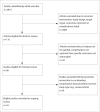Predictors of bleeding complications following percutaneous image-guided liver biopsy: a scoping review
- PMID: 30644369
- PMCID: PMC6339629
- DOI: 10.5152/dir.2018.17525
Predictors of bleeding complications following percutaneous image-guided liver biopsy: a scoping review
Abstract
Purpose: Percutaneous tissue biopsy is a mainstay of diagnostic and interventional radiology, providing a minimally invasive method for diagnosing malignant and benign disease. The purpose of this review was to collect and summarize the best available evidence regarding the risk factors associated with bleeding complications in image-guided liver biopsy.
Methods: A literature review was performed, searching Medline, EMBASE, CINAHL, the Cochrane Library, the National Institute for Health and Care Excellence (NICE) and Canadian Agency for Drugs and Technology in Health (CADTH) databases for any studies evaluating bleeding complications in image-guided liver biopsy. A total of 68 articles, published between January 1994 and April 2015, were reviewed in full, with 34 ultimately eligible for inclusion in the review.
Results: Bleeding of any kind occurred in up to 10.9% of image-guided liver biopsies, with major bleeding episodes ranging from 0.1% to 4.6% and minor bleeding events occurring in up to 10.9% of biopsies. The overall rate of bleeding was, however, found to be less than 2%. Several risk factors (patient, operator, and procedure-related) were identified as potentially indicative of an increased risk of post-biopsy bleeding. Patient-related risk factors included patient age (>50 years or <2 years), inpatient status (8/12 vs. 4/12, P < 0.001), comorbidities and/or concurrent diagnoses and coagulation status (rate of bleeding was 3.3% for international normalized ratio [INR] 1.2-1.5 vs. 7.1% for INR >1.5, P < 0.001). There was no consensus on impact of operator experience (>200 biopsies/year vs. <50/year) on post-biopsy bleeding rate. Procedure-related risk factors included needle size (cutting biopsy vs. fine needle aspiration, P < 0.001) and the presence of a patent track on post-biopsy ultrasound (P < 0.001). Lastly there was no difference found between targeted vs. nontargeted biopsies and number of needle passes.
Conclusion: Reported rate of post-biopsy bleeding ranges between 0% and 10.9%, although the vast majority of studies reported bleeding rates under 2%. Several patient, operator, and procedure-related risk factors are associated with a higher risk of bleeding following liver biopsy.
Conflict of interest statement
The authors declared no conflicts of interest.
Figures
References
Publication types
MeSH terms
LinkOut - more resources
Full Text Sources
Medical
Miscellaneous


